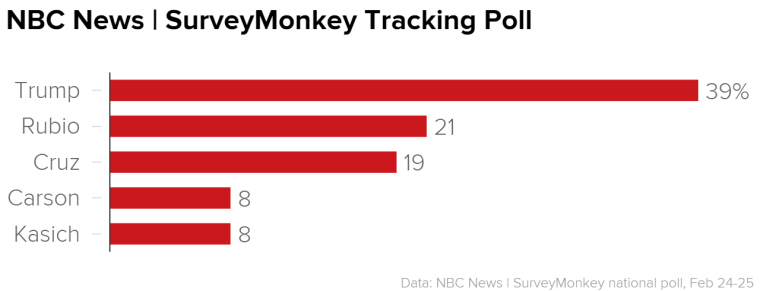Donald Trump remains the leader of the Republican presidential race, getting support of 39 percent of GOP voters after his three-straight victories in New Hampshire, South Carolina and Nevada, according to the latest online NBC News|SurveyMonkey poll.

-- 67 percent have an unfavorable view of Americans Muslims (versus 35 percent of all voters who say this);
-- 87 percent support a temporary ban against all Muslims who aren't U.S. citizens from entering the United States (versus 47 percent of all voters);
-- 55 percent believe illegal immigrants working in the United States should be deported (versus 29 percent all voters)
-- 45 percent describe themselves as "pro-choice" on abortion (versus 60 percent of all voters and 34 percent of Republicans);
-- and 50 percent want to raise the minimum wage to either $10 or $15 an hour (versus 72 percent of all voters and 49 percent of Republicans).
In the GOP horserace, Trump's 39 percent is followed by Marco Rubio at 21 percent, Ted Cruz at 19 percent and Ben Carson and John Kasich at 8 percent each.
In the Democratic horserace, Hillary Clinton leads Bernie Sanders by 11 points, 52 percent to 41 percent.

The NBC News|SurveyMonkey Poll was conducted online from February 24, 2016 through February 25, 2016 among a national sample of 7,230 adults aged 18 and over including 6,433 who say they are registered to vote and 1,007 voters who say they are supporting Donald Trump in the Republican primary. Respondents for this survey were selected from the nearly three million people who take surveys on the SurveyMonkey platform each day. Data for this week has been weighted for age, race, sex, education, region, and voter registration status using the Census Bureau and Bureau of Labor Statistic’s Current Population Survey to reflect the demographic composition of the United States. Because the sample is based on those who initially self-selected for participation rather than a probability sample, no estimates of sampling error can be calculated. All surveys may be subject to multiple sources of error, including, but not limited to sampling error, coverage error, and measurement error. To assess the variability in the estimates and account for design effects, we create a bootstrap confidence interval to produce an error estimate. The bootstrap confidence interval for this survey is plus or minus 1.8 percentage points for the full sample and plus or minus 1.9 percentage points for registered voters. To calculate the bootstrap confidence interval we use the weighted data to generate 5000 independent samples and calculate the 95% confidence intervals for the weighted average. When analyzing the survey results and their accuracy, this error estimate should be taken into consideration in much the same way that analysis of probability polls takes into account the margin of sampling error.
